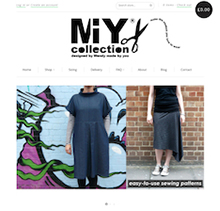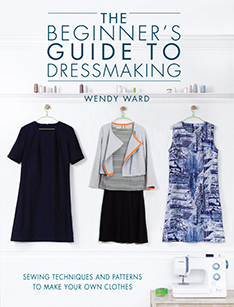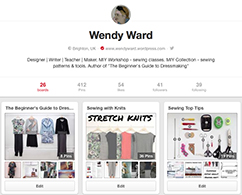The mainstream sewing world seems to be catching on to the idea of gender neutral sewing patterns and the joy of sewing your own great quality core basics.
I was interviewed on that very subject by this month’s Simply Sewing magazine (issue 72). I thought you all might enjoy reading the full un-edited version of my interview, so here it is:
1. What inspired you to write ‘Sewing Basics for Every Body’?
I’ve always loved to sew good quality basics that I know will get lots of wear. I’m really interested in and passionate about sustainability in textiles, fashion and sewing, and making clothes that get lots of wear rather than being kept for “best” is an important part of this approach for me. My teaching experience tells me that a big reason people start to sew is that they can’t find the right clothes for them when they go clothes shopping and they feel alienated by that. Despite being a trained and experienced fashion designer I’m not a follower of fashion, rather, I believe in the right of everyone to create and follow their own style. The joy of good quality handmade clothes is something that I believe can be achieved by all makers regardless of age, size, gender or ability. You just need to feel that there’s an achievable place you can get started. I really wanted to write a book that celebrated the individual and encouraged readers to feel empowered by making their own clothes in their own style to fit their own body.
2. Have you seen a rise in the popularity of people sewing their own gender neutral clothing?
I think it’s always been there, it’s just become more visible.
There are more people enjoying sewing than the stereotypical young, slim white woman which is the image that so often accompanies sewing patterns, books, magazines and blogs. To be honest I was getting tired of it and feeling like the sewing world was becoming a reflection of the fashion world. There is a whole real world of ages, shapes, styles and skill levels of makers out there.
3. What are the key points to consider when sewing your own unisex clothing?
They’re no different to the points you should consider when sewing any kind of clothing: choose the right fabric for the pattern, choose the best quality fabric you can afford, choose a pattern style and fabric colour / print that you would actually want to wear, ask yourself if the garment you’re planning to make will fit with the rest of your wardrobe and will it be something you reach for again and again. You’re going to spend a lot of time (and often a lot of money) making it, you want to wear it more than a handful of times!
4. What pieces tend to work best for various body shapes?
I’m really not into the prescriptive approach to dressing based on which styles work on which body shape. I think today’s makers have moved beyond that approach that started in the 40’s and 50’s and was still prevalent in the 80’s. To me, making your own clothes is such an empowering and defiant act, that I encourage everyone to make whatever style you want as long as you know you’re going to wear it. The patterns in the book are loose fitting without any dart shaping but there are instructions on how to add darts and do full bust adjustments.
5. What has been the feedback since your book was released?
Really positive, readers seem to love the diversity of the models we used and the adaptable style of the patterns. Each of the five projects in the book starts with a basic pattern and then walks you through how to make several different versions of it. For example, from the Felix project you can make a t-shirt, hoodie, sweatshirt, bomber jacket or jumper dress!
6. What’s your favourite design in the book and why?
I had been wanting to design and make a coat for a long time (having made several for other people over the years), but I just never seemed to find the time, so I was really happy to be able to include a coat and jacket pattern in the book. I love getting stuck into a longer, more complex project. The Dylan coat project gives you the opportunity to really hone your skills, take it slow and enjoy the process. It’s so satisfying when the end result becomes a key part of your wardrobe that can be worn year after year and I tried to come up with some classic designs that won’t date so that you’ll be able to make them time and again in a wide range of fabrics.
I have to say that the way some of these questions were framed troubled me, questions 2, 3 & 4 in particular got my hackles up a bit. That said I should be focussing on the positive that is a mainstream national sewing magazine devoting 2 double page spreads to the subject of gender neutral sewing. That has to be a good thing and Simply Sewing should be congratulated for that.
There is more diversity to found in the rest of the issue too. I enjoyed reading the inspiring interview with Leila Kelleher of indie sewing pattern brand Muna and Broad which creates what Leila herself describes as plus-size PDF patterns. If you find you regularly fall outside the sizing offered by sewing pattern companies, check out Muna and Broad, I think you’ll love their approach to sizing and their gorgeously wearable designs. There are also interviews with John Scott who was a presenter on crafting TV channel Sewing Quarter and Pete Cant from the last series of the Great British Sewing Bee.
It definitely feels to me like the mainstream sewing world is making some great progress on inclusivity in terms of size, gender and race, but as we all know, there is always more work to be done. I’d love to see a national publication or TV show devote some space to the issue of making sewing and crafting accessible to those who are economically excluded. Let’s face it, if you’re struggling to afford to put food on the table, sewing and crafting of most kinds is going to seem pretty inaccessible to you. The craft industry is rife with work for free unpaid “opportunities”, Instagram posts full of fabric “hauls” and sponsored posts of lovely expensive sewing machines, not to mention the space you need to sew and the time. It’s a lovely luxury available to a privileged few. I can sense a rant coming on, but that’s for another post….one that’s been in my drafts since 2016 with a working title of “We Need to Talk About Money: Why is Creative Work Valued so Little?”
Got thoughts on any of this? I’d love you to share them in the comments. It’s good to talk.




















Hi Wendy. I would REALLY like to read ‘We Need to Talk About Money: Why is Creative Work Valued so Little?’ Please write it! I’ve been wanting to write something similar for some time, in my case from the perspective of a writer – writing being frequently devalued within online creative communities where hobbyists and businesses intersect. It’s hard to know where to start… Thanks for sharing the interview – really interesting, though question 4 gave me the shivers!
LikeLike
Thanks for taking the time Ruth! I know what you mean about question 4….. I have a feeling that a piece about money will really resonate with a lot of professionals and may be quite opening for makers. I want to write it in a dispassionate, factual way and back up what I’m writing with facts so that it doesn’t just sound like I’m having a rant. Maybe I should put together a few questions for fellow professionals to answer, thinking as I’m typing here!! If I did would you be up for being involved??
LikeLiked by 1 person
Hi Wendy, Yes, I’d be happy to be involved!
LikeLike
Fantastic! What’s the best email address for you?
LikeLike
ruth@grinlowsews.com – looking forward to hearing from you!
LikeLike
That email address seems to be a bit flaky (my site is v new!) if it doesn’t work you can contact me here: https://grinlowsews.com/contact-2/
LikeLike
Eek, question 4 just made me squirm a little (missing the point much?) but love your answer!
LikeLike
I know, I had exactly the same reaction Helen! I’m glad you think my answer addressed it :o) I also think that answer was well edited into the final piece as it appears in the magazine.
LikeLike
As someone who always has to make a FBA I don’t see how gender neutral clothing is going to be right for me.
LikeLike
I think we just have to accept that as with any sewing pattern, some adjustments will always be necessary. I don’t see how it could be possible to draft a pattern in proportions and sizes to fit every possible body shape without making something incredibly confusing. That’s why I included instructions for how to add darts, do FBAs and lengthen parts on my patterns in my book. A bit of pattern adjustment knowledge is a powerful thing as I imagine you’ve probably found doing your FBAs! I think it’s also empowering to know your body shape so well :o)
LikeLike
When it comes to gender-neutral clothing, in my experience it often means simply “women” wearing “men’s” clothing as opposed to clothing that is truly designed for women and men of any body type to enjoy equally. It seldom works the other way – that a man wears something designed for women. It seems that women have to do the adapting. Can you provide examples of clothing truly designed for any gender to enjoy equally?
LikeLiked by 1 person
Thanks for sharing your thoughts. In my experience (living in the UK) I’m seeing more and more brands making truly gender neutral clothing available, I only have to google “gender free clothing uk” for some great looking clothes to come up, beyond the obvious t-shirts, shirts, sweatshirts, hoodies, trackies and jeans. Now the nitty gritty of making clothes to fit all body shapes, that’s tricky. I’m not sure how all the RTW brands do it as there is so much variation in height, limb length, shoulder width and chest-waist-hip ratios. That’s why I think the key is to make your own, or have a few sewing skills under your belt to alter RTW. I have personally seen, met and know “men” who wear “women’s” clothing. I’ve had men in my sewing classes using my patterns (before I designed my unisex range for my book). I found it refreshing and it’s probably what inspired me to start making gender-free or unisex patterns.
LikeLike
That’s I’ll check that out. I think that instead of talking about gender and clothing it makes more sense to talk about body type and clothing. Pants for example need three waist-to-hip ratio options – depending on whether the waist is smaller, larger or about the same as the hips. Plus you need a few crotch length and depth options. Plus leg length options. It gets tricky fast but it can be done!
LikeLike
Exactly!! I completely agree, body shapes aren’t always unique to a particular gender. It’s where rtw (and to some extent sewing patterns) fall down – they have to try and shoehorn all of humanity into just a few pigeon holes!! Then if you try to find a way of including all those variations into a sewing pattern it can also quickly get really dauting for beginner makers. Have you seen https://www.jumpsu.it they’ve had a really good go at it and are doing some really interesting things.
LikeLike
Brilliant interview Wendy. Thank you for posting the full interview I thoroughly enjoyed reading it.Irene
LikeLike
Thanks Irene!!
LikeLike